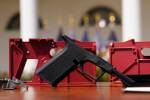Plan early if your hunting trip requires airline travel
Though the days of fall may still seem distant, hunting season is fast approaching, and for some of you that will include journeying to other states, or perhaps another country. Such adventures often involve airline travel, which poses some unique challenges for those who will have firearms or bows and arrows in tow.
I recommend planning early just to make sure you have time to make any necessary adjustments in your plans, your equipment list and legal paperwork. The first stop on your list should probably be the Transportation Safety Administration (TSA) website. There you will find the federal government’s rules for traveling with firearms and other sporting equipment. The information you need is found in two separate places within the website, one is entitled Firearms and Ammunition, and the other Hunting and Fishing Equipment.
According to the TSA, “Firearms, ammunition and firearm parts may only be transported in checked baggage. Firearms, ammunition and firearm parts are prohibited from carry-on baggage.” And all firearms must be unloaded and transported in a locked, hard-sided container secure from access.
Title 49 of the Code of Federal Regulations, defines a loaded firearm as one that has “a live round of ammunition, or any component thereof, in the chamber or cylinder or in a magazine inserted in the firearm.” When you declare your firearm at the ticket counter as required, you will be asked whether the gun is loaded.
Contrary to some reports, you can store your ammunition in the same case as your firearm, but it cannot be loose. Ammunition “must be securely packed in fiber (such as cardboard), wood or metal boxes or other packaging specifically designed to carry small amounts of ammunition.” The original packaging should meet this requirement. Also, most airlines limit passengers to no more than 11 pounds of ammunition.
Hard-sided gun cases are readily available through most major outdoor retailers, but don’t get suckered in by the price tag — low or high. Keep in mind that the case is not only to meet TSA requirements, but also to protect your rifle or shotgun from baggage handlers. If at all possible go to the store and give cases a hands-on look before making your purchase. In addition to quality and cost, something else to consider is the locking mechanism. A case that permits you to use a heavy duty padlock rather than a built in lock may be more secure.
Archers are bound by similar restrictions insomuch that “bows and arrows are prohibited from carry-on luggage. These items should be packed in checked luggage. Any sharp objects (including hunting knives) packed in checked luggage should be sheathed or securely wrapped to prevent injury to baggage handlers and security screeners,” says the TSA.
Muzzleloading enthusiasts have things a little tougher because it is against the law to transport black powder, Pyrodex, percussion caps, primers, etc. in carry-on or checked baggage. If you are hunting stateside this should prove to be little more than an inconvenience, depending on your destination and the retail outlets available there. However, if you are going to Canada or Africa, this could be an issue. Work with your guide early to make the necessary arrangements so you have what you need upon arrival.
Something else to keep in mind is that the various airlines, states, local governments and countries may have additional rules that vary by carrier and location. Do yourself and those you’re traveling with a favor by researching these rules ahead of time. Don’t wait until someone in authority pulls you aside and says you’re in trouble, especially if you will be landing on foreign soil or someplace like New York.
Moreover, “all persons who intend to travel from the United States to a foreign country with firearms and/or ammunition are reminded that both the permanent and temporary exportation of these items are subject to federal export licensing regulations,” according to U.S. Customs and Immigration Enforcement. Details — and lots of them — can be found online at http://www.ice.gov/cpi/faq.
Freelance writer Doug Nielsen is a conservation educator for the Nevada Department of Wildlife. His “In the Outdoors” column, published Thursday in the Las Vegas Review-Journal, is not affiliated with or endorsed by the NDOW. Any opinions he states in his column are his own. He can be reached at intheoutdoorslv@gmail.com.




























